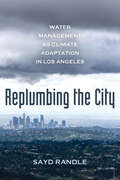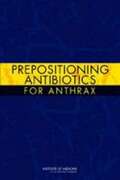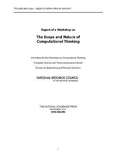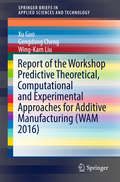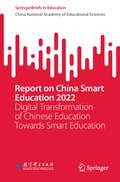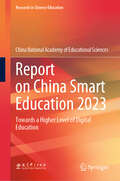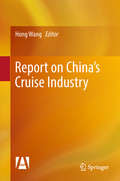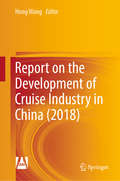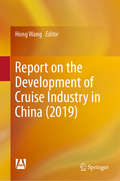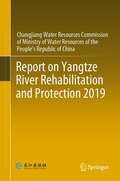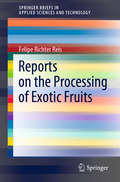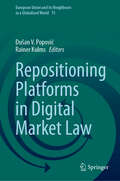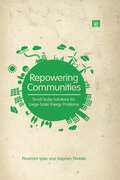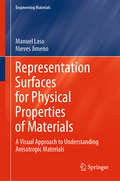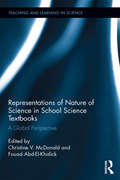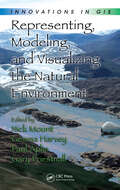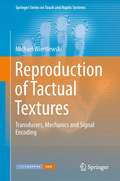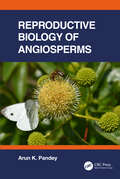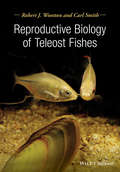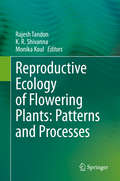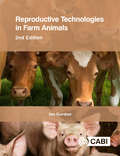- Table View
- List View
Replumbing the City: Water Management as Climate Adaptation in Los Angeles
by Sayd RandleMoving between shower drains, aqueducts, rain gardens, and even kitchen sinks, Replumbing the City traces the enormous urban waterscape of Los Angeles in a state of flux. For more than a century, the city of Los Angeles has relied on faraway water for the vast majority of its municipal supply, but climate change is making these distant sources much less dependable. To adapt, Angelenos—including city engineers, advocates at NGOs, and residents—are developing new water supplies within the space of the city. Sayd Randle’s ethnography examines the labor of replumbing LA’s sprawling water system, detailing how a desire to sustain unlimited and uninterrupted water provision for paying customers is reshaping the urban environment and its management. Tracking how such projects redistribute the work of water management, the book explores thorny questions of how the labor of climate adaptation should be mobilized and valued.
Report From Ground Zero: The Story Of The Rescue Efforts At The World Trade Center
by Dennis SmithReport compiled by a practicing NYC fire fighter within three months of September 11.
Report of a Workshop on Science, Technology, Engineering, and Mathematics (STEM) Workforce Needs for the U.S. Department of Defense and the U.S. Defense Industrial Base
by Committee on Science Technology Engineering Mathematics Workforce Needs for the U.S. Department of Defense the U.S. Defense Industrial Base"Report of a Workshop on Science, Technology, Engineering, and Mathematics (STEM) Workforce Needs for the U. S. Department of Defense and the U. S. Defense Industrial Base" is the summary of a workshop held August 11, 2011, as part of an 18-month study of the issue. This book assesses the STEM capabilities that the Department of Defense (DOD) needs in order to meet its goals, objectives, and priorities; to assess whether the current DOD workforce and strategy will meet those needs; and to identify and evaluate options and recommend strategies that the department could use to help meet its future STEM needs.
Report of a Workshop on the Scope and Nature of Computational Thinking
by National Research Council of the National AcademiesReport of a Workshop on the Scope and Nature of Computational Thinking presents a number of perspectives on the definition and applicability of computational thinking. For example, one idea expressed during the workshop is that computational thinking is a fundamental analytical skill that everyone can use to help solve problems, design systems, and understand human behavior, making it useful in a number of fields. Supporters of this viewpoint believe that computational thinking is comparable to the linguistic, mathematical and logical reasoning taught to all children. Various efforts have been made to introduce K-12 students to the most basic and essential computational concepts and college curricula have tried to provide a basis for life-long learning of increasingly new and advanced computational concepts and technologies. At both ends of this spectrum, however, most efforts have not focused on fundamental concepts. The book discusses what some of those fundamental concepts might be. Report of a Workshop on the Scope and Nature of Computational Thinking explores the idea that as the use of computational devices is becoming increasingly widespread, computational thinking skills should be promulgated more broadly. The book is an excellent resource for professionals in a wide range of fields including educators and scientists.
Report of the Committee on Proposal Evaluation for Allocation of Supercomputing Time for the Study of Molecular Dynamics: Third Round
by National Research Council of the National AcademiesThe committee evaluated submissions received in response to a request for proposals (RFP) for Biomolecular Simulation Time on Anton, a supercomputer specially designed and built by D.E. Shaw Research (DESRES) that allows for dramatically increased molecular dynamics simulations compared to other currently available resources. During the past 2 years, DESRES has made available to the non-commercial research community node-hours on an Anton system housed at the Pittsburgh Supercomputing Center (PSC), based on the advice of previous National Research Council committees convened in the falls of 2010 and 2011.
Report of the Workshop Predictive Theoretical, Computational and Experimental Approaches for Additive Manufacturing (WAM #2016)
by Xu Guo Gengdong Cheng Wing-Kam LiuThe volume focuses on theoretical and computational approaches and involves areas such as simulation-based engineering and science, integrated computational materials engineering, mechanics, material science, manufacturing processes, and other specialized areas. Most importantly, the state-of-the-art progress in developing predictive theoretical, computational and experimental approaches for additive manufacturing is summarized.
Report on China Smart Education 2022: Digital Transformation of Chinese Education Towards Smart Education (SpringerBriefs in Education)
by China National Academy of Edu., SciencesThis book aims to reflect the digital transformation of Chinese education toward smart education comprehensively and accurately. It is the first systematic summary of the progress of smart education in China. The book believes that smart education is a new education form in the digital era and is essentially distinct from education forms in the industrial era. This new education form is innovative in five dimensions. First is the new core concept. Smart education is not only a concrete action concerning people’s well-being, but also a vital strategy concerning national plans. Through technology empowerment and data drive, it empowers educational reform in all aspects, systematically constructs a new relationship between education and society, provides suitable education for each learner, and makes the aptitude-based teaching that we have been dreaming of for thousands of years a reality. For the first time in history, smart education helps to reach the full alignment between individual development and societal development. Second is the new system structure. Smart education will break through the boundaries of school education, drive the diversified combination of various education types, resources, and elements, promote the collaboration of school, family, and society in education, and build a high-quality, individualized lifelong learning system that is available for anyone anywhere anytime. Third is the new teaching paradigm. Smart education will integrate physical, social, and digital spaces to create new learning scenarios and promote human–technology integration, and cultivate cross-grade, cross-class, and cross-discipline learning communities across time and space to organically combine large-scale education with individualized cultivation. Fourth is the new educational content. Smart education will focus on developing all-round education, establishing digital knowledge graphs based on systematic logics of knowledge points, and innovating content presentation methods to make learning a wonderful experience and help learners develop higher-order thinking skills, comprehensive innovation capability, and lifelong learning ability. Fifth is the new education governance. With data governance at the core and digital intelligence technology as the driver, smart education will boost the holistic reengineering of education administration and business processes and enhance the modernization of the education governance system and governance capacity. This book is intended for teachers, education administrators, education policymakers, education researchers, and parents concerned about education innovation and development, as well as people from all walks of life who have aspirations for the education industry. It can also serve as a reference for international organizations and education research institutions of all countries to promote the joint exploration of the development path of smart education and create a better future for the world’s mutual development through educational reform.
Report on China Smart Education 2023: Towards a Higher Level of Digital Education (Research in Chinese Education)
by China National Academy of Educational SciencesThis book provides a comprehensive overview of the development of smart education in China. It defines smart education as a higher level of digital education that can be divided into four stages, including resource sharing, data-driven, integration with AI, and ecology reshaping. It proposes five practical paths for the development of smart education in China, such as cultivating innovation literacy as its goal and data empowerment as its core, and it develops an evaluation framework consisting of four dimensions, including extensive connectivity, innovative application, mechanism guarantee, and literacy improvement. Finally, it also identifies five trends in the global development of digital education. This book serves as a valuable resource for teachers, education administrators, education researchers, and other readers who are interested in educational innovation and development in China.
Report on China’s Cruise Industry
by Hong WangThe book contains 12 contributions that explain the current state of China’s cruise industry and future development. Dating from the 1960s and with the rapid development of over 50 years, the modern cruise industry has developed into one of the fastest growing industries with the most remarkable economic benefits in the global tourism and hospitality industry, known as a “golden industry on the golden waterway”. In recent years, with the gradual saturation of international cruise market and the eastward-moving trend of the center of cruise market, China has become a strategic emerging market with which international cruise lines have been competing. A number of international cruise lines, including Costa Crociere, Royal Caribbean Cruises, Princess Cruises, MSC Cruises, Star Cruises, Norwegian Cruise Line and Dream Cruises, have entered the cruise market in Mainland China.
Report on the Development of Cruise Industry in China (2018)
by Hong WangThis book is an annual research report prepared by the cruise industry experts and scholars at home and abroad invited by Shanghai International Cruise Business Institute based on the current development situations of the international cruise industry, is an important part of the “X Book Series” of the Social Science Academic Press (China). This book consists of five parts, i.e., “General Report”, “Special Articles for High-quality Tourism: Common Value and Government Management”, “The Cruise Industry”, “Policy Suggestions” and “Appendix”, and it has richer and more perfect contents in comparison with the previous versions. Under the Book, the development environment of the cruise industry at home and abroad during 2017-2018 as well as the development situations, strategic paths and future trends is analyzed in the form of the General Report and the current development trend of the cruise industry in China is introduced based on the top ten hot topics. With the economic development trend from the high-speed growth to the high-quality development in China, the new topic “Special Articles for High-quality Tourism: Common Value and Government Management” is presented in the Book to discuss the quality development patterns and paths of the cruise tourism in China, the high-quality development mechanism of the cruise tourism as well as the cruise tourism market cultivation and standardization system, so as to better enhance the quality of the cruise market development in China. In Part 3 “The Cruise Industry” and Part 4 “Policy Suggestions” under the Book, the whole picture of the cruise economy in China in the new era is presented, problems during the industrial development are analyzed and corresponding policy suggestions are given.
Report on the Development of Cruise Industry in China (2019)
by Hong WangThe book focuses more on the study of cruise economy industry chain based on the previous editions and the latest trend of China’s cruise economy. It includes the Special Topic: Cruise Economic Reform and Innovation in the New Era, explores Asia cruise economic prosperity index, China’s cruise economy whole-industry-chain strategy in the new era, and the development of cruise destinations in the context of the Yangtze River Delta integration. The volume provides a good reference for better promoting the high-quality development of China’s cruise market.
Report on Yangtze River Rehabilitation and Protection 2019
by CWRCThis book summarizes the achievements and experience of the Yangtze River rehabilitation and protection, analyzes the new situation and requirements of the Yangtze River rehabilitation and protection, and discusses the main issues and their solution alternatives for the Yangtze River rehabilitation and protection efforts. The Yangtze River, respected as the mother river of the Chinese nation, contributes immensely toward the socioeconomic development of China and braces up the national strategies such as the development of the Yangtze River Economic Belt and the integrated development of the Yangtze River Delta, etc. Whether the Yangtze River is under good stewardship has implications on not only the wellbeing of more than 400 million inhabitants in the basin, but also in broader sense the overall sustainability of socioeconomic development of the whole country. This book which has two parts, provides a multidirectional analysis of Yangtze River rehabilitation and protection. The first part explores the stages, achievements, and the future of the Yangtze rehabilitation and protection. Major issues existing in Yangtze River Basin rehabilitation and protection are discussed in the second part. Many pictures, charts, and diagrams are involved providing an understanding of the situation of Yangtze River Basin.
Reporting Research
by R. S. ClymoWant to learn how to present your research successfully? This practical guide for students and postdoctoral scholars offers a unique step-by-step approach to help you avoid the worst, yet most common, mistakes in biology communication. Covering irritants such as sins of ambiguity, circumlocution, inconsistency, vagueness and verbosity, misuse of words and quantitative matters, it also provides guidance to design your next piece of work effectively. Learn how to write scientific articles and get them published, prepare posters and talks that will capture your audience and develop a critical attitude towards your own work as well as that of your colleagues. With numerous practical examples, comparisons among disciplines, valuable tips and real-life anecdotes, this must-read guide will be a valuable resource to both new graduate students and their supervisors.
Reporting Results
by David C. Van Aken William F. HosfordThis brief guide is ideal for science and engineering students and professionals to help them communicate technical information clearly, accurately, and effectively. The focus is on the most common communication forms, including laboratory reports, research articles, and oral presentations, and on common issues that arise in classroom and professional practice. This book will be especially useful to students in a first chemistry or physics laboratory course. Advanced courses will often use the same formatting as required for submission to technical journals or for technical report writing, which is the focus of this book. Good communication habits are appropriate in all forms of technical communication. This book is designed to help the reader develop effective communication skills. It is also ideal as a reference on stylistic and grammar issues throughout a technical career. Unlike most texts, which concentrate on writing style, this book also treats oral presentations, graphing, and analysis of data.
Reports on the Processing of Exotic Fruits (SpringerBriefs in Applied Sciences and Technology)
by Felipe Richter ReisThis book presents exotic fruit processing as a way to obtaining traditional and innovative fruit products by means of various food processing technologies. Built on the basis of specific, up-to-date and reliable scientific reports, it is a unique document for instructing researchers, processors and enthusiasts in the field of exotic fruit processing.
Repositioning Platforms in Digital Market Law (European Union and its Neighbours in a Globalized World #15)
by Dušan V. Popović Rainer KulmsOnline platforms and their ecosystems are the cornerstone of the digital economy. They have brought forth positive network effects. But they are also known for their information asymmetries, their potential for market failures and their problematic relationship with data protection law. This volume provides a detailed analysis of the current process of repositioning online platforms in the digital economy as regulators express concerns about the evolution from mere intermediaries to gatekeepers. The exclusive reliance on competition law instruments has proven to be incapable of coping with cases of platforms abusing their market power. Therefore, the book explores the European Union's new approach to digital markets consisting in the adoption or drafting of new legislative instruments, such as the Digital Markets Act, Digital Services Act, Proposal of AI Act, Proposal of Data Act, Proposal of Data Governance Act. The EU's emphasis on new regulatory ex ante instruments (as in the Digital Markets Act) calls for an assessment of their overlap or their interface with existing supranational and national competition rules. The book transcends mere competition law thinking by exploring the status of online platforms from the perspective of trade law rules, unfair competition law, data protection rules and intellectual property law. But in view of the global reach of online platforms, the risks of a jurisdiction-wise approach with conflicting regulatory strategies are all too clear. The volume therefore includes comparative studies on Australia and the USA. The potential impact of regulatory policy choices will also be assessed from the economic perspective. The book's message is not be confined to researchers and academics. It is also of great importance to practitioners in the digital sector who stand to benefit from the analysis of the law of online platforms, undertaken by a working group of renowned authors coming from different jurisdictions.
Repowering Communities: Small-Scale Solutions for Large-Scale Energy Problems
by Prashant Vaze Stephen TindaleEnergy policy is at a crossroads. Attempts to meet targets for carbon emissions, energy security and affordable energy for vulnerable households are all on a trajectory to failure. Aggressive ambitions to roll out huge off-shore wind, nuclear and clean coal plants are proposed, but without any clear plans on how funds will be mobilized, or transmission and distribution infrastructure developed. In this book Prashant Vaze and Stephen Tindale ask politicians and regulators to consider a different path. Using abundant examples of small scale local solutions Repowering Communities examines how cities, communities and local authorities from across Europe and North America have driven reductions in energy use and rolled out small scale, community level solutions. Among the issues examined are the drivers behind behavioural change, the methods used to secure necessary investment and what government and civil society can do to foster such action on a wide scale. Based on extensive first-hand research and drawing on the latest global energy data the authors provide essential information and inspiration for readers who wish to drive the policies that encourage community-level energy development.
Representation Surfaces for Physical Properties of Materials: A Visual Approach to Understanding Anisotropic Materials (Engineering Materials)
by Manuel Laso Nieves JimenoThis textbook presents all the mathematical and physical concepts needed to visualize and understand representation surfaces, providing readers with a reliable and intuitive understanding of the behavior and properties of anisotropic materials, and a sound grasp of the directionality of material properties. They will learn how to extract quantitative information from representation surfaces, which encode tremendous amounts of information in a very concise way, making them especially useful in understanding higher order tensorial material properties (piezoelectric moduli, elastic compliance and rigidity, etc.) and in the design of applications based on these materials. Readers will also learn from scratch concepts on crystallography, symmetry and Cartesian tensors, which are essential for understanding anisotropic materials, their design and application. The book describes how to apply representation surfaces to a diverse range of material properties, making it a valuable resource for material scientists, mechanical engineers, and solid state physicists, as well as advanced undergraduates in Materials Science, Solid State Physics, Electronics, Optics, Mechanical Engineering, Composites and Polymer Science. Moreover, the book includes a wealth of worked-out examples, problems and exercises to help further understanding.
Representations of Nature of Science in School Science Textbooks: A Global Perspective (Teaching and Learning in Science Series)
by Christine V. McDonald Fouad Abd-El-KhalickBringing together international research on nature of science (NOS) representations in science textbooks, the unique analyses presented in this volume provides a global perspective on NOS from elementary to college level and discusses the practical implications in various regions across the globe. Contributing authors highlight the similarities and differences in NOS representations and provide recommendations for future science textbooks. This comprehensive analysis is a definitive reference work for the field of science education.
Representing, Modeling, and Visualizing the Natural Environment (Innovations in GIS)
by Nick Mount Gemma Harvey Paul Aplin Gary PriestnallThe explosion of public interest in the natural environment can, to a large extent, be attributed to greater public awareness of the impacts of global warming and climate change. This has led to increased research interest and funding directed at studies of issues affecting sensitive, natural environments. Not surprisingly, much of this work has re
Reproduction of Tactual Textures
by Michaël WiertlewskiTexture accounts for an important part of the realism of simulated experiences, and it is most certainly true during tactile interaction. We usually experience roughness by running our fingers onto the explored surface. The perception of this fine texture is mediated by the vibrations generated by the encounters of the skin and the asperities of the surfaces. Reproduction of Tactual Textures presents factors that contribute to the mechanics of the interaction between a bare finger and a surface with a view to their artificial reproduction. It discusses the recording and reproduction of tactual textures, and analyses a case study of the development of a device able to record the vibratory signal from a fingertip sliding over a textured surface. The same device is then used in a reverse way to render those previously measured signals to the user's fingertip. These developments open new questions about the biomechanical properties of the skin and their relation to perception. The second half of Reproduction of Tactual Textures focuses on the implication of the dynamic parameters of the skin onto rendering performance, and it concludes with a study on the important features that are present in the vibratory signal and their relation to texture perception. This state-of-the-art volume highlights the importance of the mechanics and biomechanics during the haptic exploration of surfaces and their possible contribution to perception. Collectively, the findings reported are pertinent to many applications, including robotic perception and the design of effective virtual reality systems.
Reproductive Biology of Angiosperms
by Arun K. PandeyThis book is designed to introduce the basics of different aspects of the biology of reproduction in a concise and coherent manner. The book aims to equip students with the fundamentals of the biology of reproduction and also update them with the most recent advances in the field of reproduction. The book has been organized into 16 chapters that introduce and explain different aspects in a stimulating manner. Each chapter is supplemented with a summary and relevant illustrations. A glossary has been added to help the students to understand some important scientific terms.The book offers comprehensive coverage of the important topics including: Flower structure and development Development and structure of male and female gametophytes Pollination biology, fertilization and self-incompatibility Endosperm, embryo and polyembryony Apomixis and seed biology A separate topic on experimental plant reproductive biology (experimental embryology) has been provided, which includes basics of cell, tissue and organ culture, anther culture, pollen culture, flower, ovary, ovule culture, embryo culture, somatic embryogenesis, synthetic seeds, protoplast culture and other aspects of plant biotechnology. The book aims to cater to the needs of the advanced undergraduate and post-graduate students in Botany, Forestry, Agriculture and related fields.
Reproductive Biology of Teleost Fishes
by Robert J. Wootton Carl SmithReproductive Biology of Teleost Fishes is the first integrated review of the reproductive biology of the bony fishes, which are the most species-rich and diversified group of vertebrates. Teleosts display remarkable variation in their modes of reproduction, and this volume is intended to provide a framework for understanding the remarkable reproductive diversity of this group. It describes their reproductive biology using, wherever possible, phylogenetic analyses and life-history theory as a means to interpret the information. The book addresses the genetic, physiological, behavioural, ecological, evolutionary and applied aspects of teleost reproduction in a comparative framework that emphasises the adaptive basis of reproductive diversity. Reproductive Biology of Teleost Fishes provides a comprehensive synthesis of fish reproduction that will be of great interest to life scientists, particularly ecologists, evolutionary biologists, physiologists and advanced undergraduates, postgraduates and research workers requiring a comprehensive overview of fish reproduction. The book is suitable for courses in fish biology and ecology, reproductive physiology and reproductive genetics. It also addresses applied questions and will be of value for courses on fisheries science and aquaculture. Libraries in all universities and research establishments where biological sciences, fisheries science and aquaculture are studied and taught should have several copies of this important book on their shelves.
Reproductive Ecology of Flowering Plants: Patterns and Processes
by Rajesh Tandon K. R. Shivanna Monika KoulSexual reproduction is the predominant mode of perpetuation for flowering plant species. Investigating the reproductive strategies of plants has grown to become a vast area of research and, in crop plants, covers events from flowering to fruit and seed development; in wild species, it extends up to seed dispersal and seedling recruitment. Thus, reproduction determines the extent of yield in crop plants and, in wild plants, also determines the efficacy of recruiting new adults to the population, making this field important both from fundamental and applied plant biology perspectives. Moreover, in light of the growing concerns regarding food and nutritional security for the growing population and preserving biological diversity, reproductive biology of flowering plants has acquired special significance. Extensive studies on various facets of reproduction are being carried out around the world. However, these studies are scattered across research journals and reviews from diverse areas of biology.The present volume covers the whole spectrum of reproductive ecology, from phenology and floral biology, to sexuality and pollination biology/ecology including floral rewards, breeding systems, apomixis and seed dispersal. In turn, transgene flow, its biosafety and mitigation approaches, and the ‘global pollinator crisis’, which has become a major international concern in light of the urgent need to sustain crop yield and biodiversity, are discussed in detail. Given its scope, the book offers a valuable resource for students, teachers and researchers of botany, zoology, ecology, agriculture and forestry, as well as conservation biologists.
Reproductive Technologies in Farm Animals
by Ian GordonBuilding on the successful structure of the first edition, the second edition of Reproductive Technologies in Farm Animals has been totally updated and revised to provide an up to date account of the key techniques employed in manipulating reproduction in farm animals, including beef and dairy cattle, pigs, sheep, goats, buffaloes, camelids, horses and poultry. A classic introductory text to the subject, the book is based on a comprehensive review of the current literature. It: - outlines different agricultural systems and explores the ethical implications of modern farming methods; - details the many new developments, including the commercial application of sexed semen and large-scale application of in vitro produced cattle embryos; - provides a valuable synopsis of current and future reproductive technologies, such as cloning and the production of transgenic animals. This text remains key reading for students in animal science, agriculture, veterinary medicine and biology, and veterinary practitioners and farmers who wish to keep updated on developments in techniques that may be useful in their daily practice.
